In life and prepping some things just make too much sense. When I first caught wind of the Earthbag I thought of a weak and insubstantial building material that was better used to stop floods temporarily. To consider a structure of any real necessity brought to mind worse visions of some of my earliest building exploits which often ended in me taking a claw hammer to the project as it fell apart from lack of stability.
I would hate to call it conspiracy but there is a lot of money to be made in building structures from plastics, wood and other traditional materials. You will be shocked to find full scale homes built of these plastered and smoothed out Earthbags. Whether they are a comparable building material when we talk about durability and longevity is not proven. Still, as preppers you will find many great uses for this cheap and effective building material.
WHAT IS AN EARTH BAG?
I wish I could offer you a much more exciting description but basically these are small durable bags, very like sandbags, that can be filled with dirt, rocks or sand. Each material has various benefits when it comes to structural integrity and insulation. Dirt will not insulate as well as the small rocks and sand will.
The earth bags are used to build frames that are surprisingly powerful. I encourage you to take a look at the various types of pressure testing, damage testing, water damage and various other tests that these bags and structures have undergone.
Related: Tents That Turn Into Bunkers if You Just Add Water
These Earthbags have been used to build everything form actual homes to beautiful root cellars and even emergency shelters. These homes do not require tensile materials at all. In other words no wood or brick. The structures are highly durable and just absurdly cheap. Most of the models I looked were around $300-500.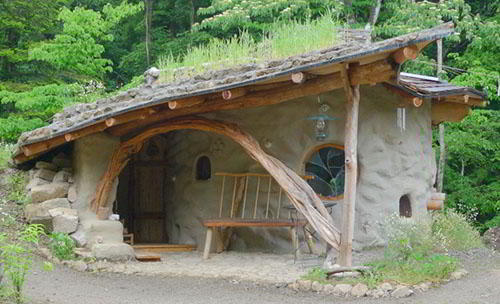
The Earthbags are stacked and arched with barbed wire between the layers in many ways to create exactly the design desired. They are then covered with stucco grating and a strong waterproof plaster.
EARTH BAGS FOR THE PREPPER
Fortification
Of course, the very basic use of these Earthbags is for fortification. These would be a great option for stopping flood waters from hurricane or other natural disasters. You could also use these bags in a more tactical and defensive modality.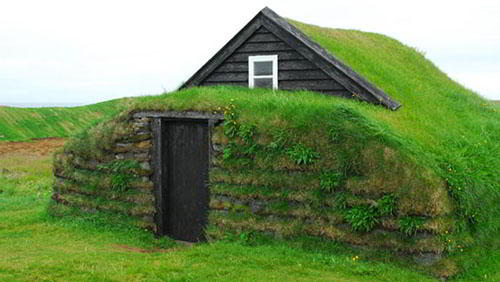
The construction of various blockades or walls for gunfire cover would also be a great option for the earthbags. You can protect your home or your community with this bags. This is a very basic use and not nearly as ambitious as it could be.
Related: Spider Hole Tactics to Defend Against Looters
Structure Building
Whether you are looking for a decent root cellar or even a smoke house the Earthbags will be your best option, when it comes to price and durability. The bags can be built into the ground in a number of very interesting designs.
All preppers are on a tight budget and with a little learning and some lifting you can create beautiful structures.
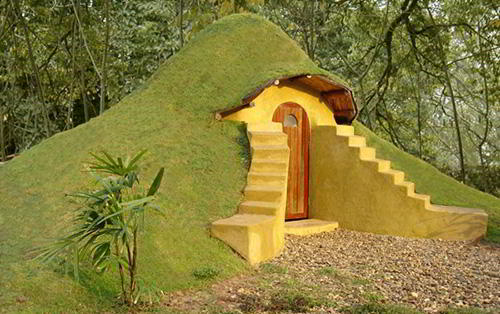 Earth Bag Bunker
Earth Bag Bunker
The design for this earthquake relief shelter make me think about how it would look underground. Could this be another cheap option to an underground bunker composed entirely of Earthbags? The long-term bunker can be a bit daunting. Not just in construction but also in theory. A family trapped underground for some duration, unable to escape each other is terrifying in and of itself.
With the Earthbags you can create several rooms of custom sizes. With the Earthbags you decide the floor plan as well as overall size. Other options, like shipping containers, are basically limited by the dimensions of the container itself.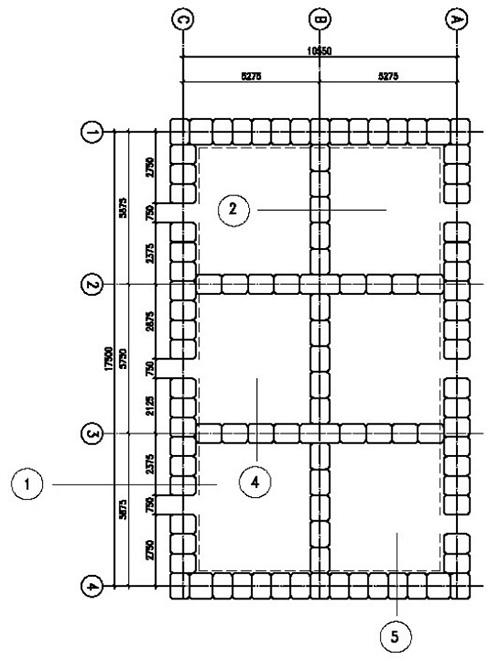
Partially Earthed Shelter
This shelter was built to aid in earthquake recovery. It is a semi permanent option for those who have lost homes due to earthquakes in the third world. The design supports a stove or a fire or both for cooking and warmth. The roof is questionable as it is primarily made of thin poles. The walls would be very durable and would insulate well.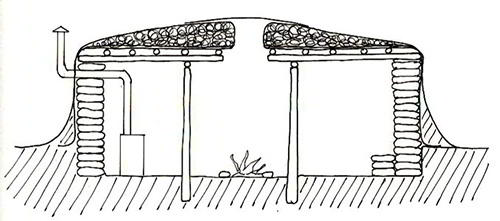
When I look at what’s possible with these Earthbag shelters I am not thinking about the pen ultimate shelter that will survive a shower of meteors and a nuclear blast. No. What I am thinking about is perhaps the best bugout option available.
For most of us we are hindered by budget when it comes to buying bugout land and then building on that land. It’s a long drawn out process that involves tons of savings and maybe even some loans. Let’s imagine, for a moment, that we get our hands on some reasonably priced land and rather than build that dream cabin you put one of these shelters on that land for a bugout home that may cost $250.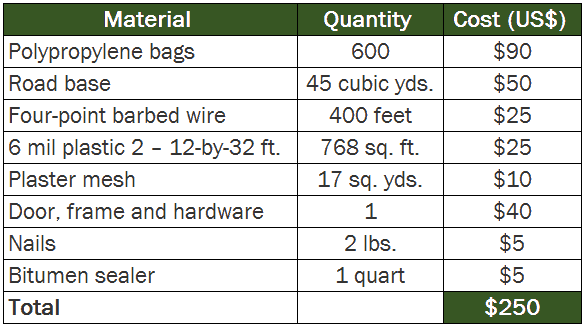
You may also like:
 How Much Does a Nuclear Bunker Cost?
How Much Does a Nuclear Bunker Cost?
How To Hide Your Home From Looters (video)
How To Make a Mini Root Cellar In Your Backyard In Less Than Two Hours

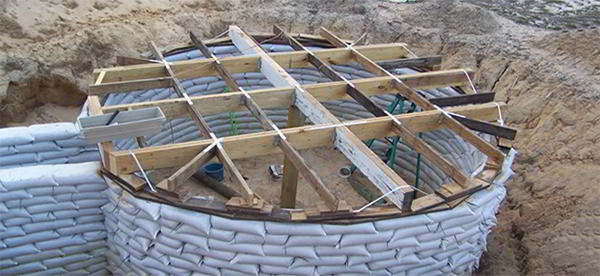













where do you buy these materials at these prices?
I agree! Not only is 600 not enough, they can’t be had for $90…I would like for this writer to make this house his next project, with an accounting of components, time and effort needed…
I agree… 45 cy of road base for $50? That’s 2 end dump trucks, and well over the 250.00 price tag.
Right?
Most of the materials can be purchased at a DIY center. I found this site for bags.
http://earthbagbuilding.com/faqs/bags.htm
Here in Oz we would be paying $40 per 100 – so 600 would be $240 – not $90 but still very cheap building.
And road base is about $80 a cubic metre in Oz which would come to $2720 for 34m3 compared $50 for 45 cubic yards… Surely there’s a mistake there, it can’t be that much cheaper in the states??
The only thing I can think of that is suitable as road base and cheap is the grindings from asphalt repaving. Small crush and run base is about $500.00 a dump truck load….
Interesting! Two questions: Wouldn’t the barbed wire poke holes in the plastic, allowing whatever is in the bags to fall or ooze out over time, with frost heaving and heavy rains? If it’s earth sheltered, what sort of retaining wall and how much backfill sand and/or pea gravel would you use to prevent the earth from moving the walls?
Believe me, after they settle in and down that won’t be a problem. For a while, I spent several months building places to live out of “sandbags”. We started with a foundation or wooden 88m.m. Ammo boxes. Built about four feet high. To make two walls. On this we put 10 ft. Pipe halves.then layer about six layers of bags.
where can you get these polypropylene bags.?Trash bags sure won’t cut it.
Try dog food bags from Pirena.
Search sandbags on ebay they even have them in camo …… store near austin tx
found these on ebay
http://www.ebay.com/itm/Trademark-Supplies-14×26-Woven-Polypropylene-Sand-Bags-With-Ties-UV-Protection-/252715506745?hash=item3ad7049c39:g:59QAAOSwZQRYcoai
Food for thought on alternative materials…and for me the key part of this article is, “Whether they are a comparable building material when we talk about durability and longevity is not proven”. So.. interesting, but with his and other concerns mentioned (barbed wire damaging the bag material, etc.. it one thing to look at component testing its another to look at the structure as a whole. I think I’ll pass until there is completed structural engineering inspection data available.
You can always fill with sand, gravel and portland cement and it will turn into a brick house as moisture gets to it …… and probably a lot cheaper than the one the song waz about……lol
not sure I’d want to have one of these around me in earthquake area either – bury yourself in aftershocks. but a tornado shelter might work…
In the southwestern part of the United States houses were built of mud bricks they were called adobe. Here in my town there is are two adobe buildings both over 100 years old. They have survived earthquakes and heavy rains. adobe is not maintenance free, it needs to be coated with a wash that resists rain but a building that is over 100 years old has a pretty good track record. The basically are adobe buildings that instead of using straw as a binder, use polypropylene bags and barbed wire as a binder.
Yes, adobe is a durable and wonderful building material — if it’s above ground, properly coated, and in an arid part of the country. The heavy rains we have back east, both because they can liquefy soil and turn it into a runny gel, and because of the increased weight load of the saturated soil on the roof, ain’t gonna work unless some other measures are taken. Like retaining walls with deadmen, seep holes, tiling, some sort of waterproofing membrane, maybe (certainly more than 6 mil), and sand/pea gravel around the perimeter. It would be a waste of time, energy, and money not to build it to withstand the climate. Unless you were building it in an emergency situation, of course! Any port in a storm, then.
I guess you haven’t been following the weather news for the west coast since December 2016. We have had rains to match anything the east coast gets outside of a hurricane. The southwest is famous for rainstorms called gullywashers where rain comes down almost as if it were coming from a firehose. In 1969 we had two storms that were billed as 500 year rain storms. In other words, their intensity was such that a rains storm of that degree would only be expected every 500 years. We had two back to back. Oops there goes that statistic. Both of the adobes that I mentioned in my earlier post survived those storms with less damage than some more modern homes of conventional construction. Adobe may not be the be all, end all, but it is a viable construction material and is cheaper than barbed wire and polypropylene bags.Yes, you need a hot sun with long hours of sunlight in order to properly bake the adobe bricks so that eliminates more northern climes because their summer days just do not get hot enough. You need dry heat, so a humid climate does not work but if you live in SoCal, Arizona, Nevada, New Mexico So. Colorado and some parts of Texas, adobe is a viable building material.
I’ve been looking at both straw bale and cob as building materials. Lots of info out there on both – problems as far as local building codes though but depends where you live. Cob is similar to adobe, but has been used for centuries in England and Wales. Some expense, but compared to conventional building materials it’s “dirt cheap” 😉
When i was in Afghanistan, they have homes made of mud brick, 2ft thick walls that were great on insulation, it’s freaking cold over there in the winter months, and can take a major pounding from small arms.
I’m also interested in where you get these materials at this price.
I would be interested in a more how to on this earth house like tips and techniques. Do you bury the first 2 courses of bags to prevent water from coming in also I think the answer to the posed question about the barb wire making holes in the bags and the concern of losing sand I would think the stucco on both the inside as well as the outside would hold it all in the wall
I suggest, with ALL structures exposed to a lot of rain, the installation of a ‘French Drain’ system all the way around the structure.
the key to bag houses and adobe house is 1)dry feet…stone to prevent wicking.. 2) dry hat…..good roof overhang with consideration of driving rain.If you take care of these, the stucco mix of sand clay and straw will last a very very long time
Early settlers on the plains were called “soddies” because their homes were built of sod. You cut the soil much like when you are buying sod for your new lawn. You stack it up on each other to build walls. You put posts on top for support for the roof sod. If you didn’t do that, you dug into the side of a hill or — preferably — dry creek bed to create a dugout. You and your family lived in that until you got enough money together to buy lumber which came from back east to build a more suitable home. The grass and roots in the sod acted as the binder for the dirt.
99% of the people now-a-days couldn’t live in an adobe earth house more than a day if that long. They would all think and complain about it not being up to code, it was disgusting, horrible, unsanitary, dangerous and unsafe, fire hazard, a safety hazard and otherwise just plain Gross.- It’s a fact. People have been spoiled and pampered too long and too much by modern day codes, living, and technology to be able to survive even one whole day, let alone one whole week, in such a shelter contraption.
For me, it would depend on the layout. I would need lots of natural light, but if you install enough windows and possibly ship’s prisms you would be ok. Straw bale/cob combo gives you insulation plus sturdiness but walls are 3ft thick ( or more) so windows would be recessed. You also need an overhanging roof which adds to the darkness within. There are some really beautiful designs out there as well as some that are just too “twee” for words, but you can customize to suit your taste. Watch local building codes though.
A tubular skylight developed in Australia in 1986 is low-tech simple for interior lighting, Miss Kitty. The one I have experience with is called SolaTube. A light-weight shiny tube goes through the roof, and has an acrylic dome that sits atop the tube on the roof. It reflects bright, natural, full-spectrum light into the interior. Even on a moonless night, there is enough light to allow getting up to go to the bathroom without turning on a light — and without waking all the way up, so one’s sleep is barely disrupted. There are a lot of bells and whistles since I bought mine in 2001, but I am perfectly satisfied with the plain vanilla ones I have. No electric needed!
I have this type of light as well. But, it is not bright enough. I am not sure why you are feeling satisfied with this dim light.
Perhaps Lucy has it positioned in a way to better gather the sunlight/moonlight therefore making it brighter on the interior..or perhaps her vision is better than yours….or perhaps the interior of her home is finished in brighter colors making the amount of light her SolaTube provides adequate for her needs. She didn’t say she was reading a book by its light…….
There’s even better ones out now. I have bought one but haven’t fitted it yet. It is a solar panel on the roof with just a insulated cable going through (under the ridge cap in my case) to a led light matched to the solar panel size. It should work well.
The whole idea of these buildings are security and safety. When you start adding windows and such, then there goes your security, you might just as well as living in a tent.
I lived for 12 years in a 400 year old adobe home in Mexico. True i had no electricity or running water, but that house was SOLID and safe and comfortable. The inside is finished with geso or you would know it as plaster. It absorbs heat in the day and releases it at night, no leaks and bullet proof. $00 years f earthquakes and not one crack. Id take it over any stupid house in the USA. I now live in a new construction adobe in Peru. No issue. Your the one who is ill informed and spoiled.And dirt doesnt burn! How is it a fire hazzard compared to a wood frame house????? And by the way i am an American Veteran
Kinda sounds like the government insuring that we can’t live without them, doesn’t it?
My Great Grandparent settled/ homesteaded, in South central Nebraska. They lived in a dugout, excavated, by hand, with a sod front and roof. They lived in it for a couple years, until they could build a barn for the livestock. They farmed with horses, the most important animal on the farm. They moved into the barn for a couple more years, until they could build a house. We can all learn from the way folks lived in the 1800s.
I love these stories from ancestors. My grandfather would visit a few settlers when he was making his rounds as a deputy marshal in Nebraska. I agree, we can learn much from the settlers of past years.
Grandpa grew up in a sod house in Kansas. He said they were dark, buggy, and moldy, and he worked really hard to have an above-ground shelter because of that. Still…in tornado country, those places would have a real advantage, wouldn’t they? Remember Greensburg, Kansas, ten years ago?
My wife and I together with a thousand other bicyclists visited Greensburg Kansas the year before the tornado destroyed the town. It was called Bike Across Kansas and has been going on for over 25 years. It was a lovely small town and we were devastated to learn that it had been destroyed by a tornado. However, unlike New Orleans where many residents of that town sat on their hands and waited “for somebody to help us,” the residents of Greensburg got together and rebuilt their town while FEMA as still trying to decide if there was a problem.
I am sure sod shelters were all of how your Grandfather described them and worse, but they sure beat sleeping outside during a tornado or a Kansas winter or sleeping in a Conestoga wagon on the open prairie. If the Kiowas were on the rampage, a soddy was certainly a better defensive position than a a Conestoga wagon or a tent.
Love your taking time to describe each step for us old school .Some- times people trip over a dollar to save a dime…just sayin
I have a friend who grew up in Chihuahua. He’s told me of going out with his father when he was a boy and digging caliche to use for construction.
What exactly is caliche?
On another survival web site I just read about a prefab dome building that can be built is less than a week and is insulated and because it is a dome, it is quite sturdy. The company is in Alaska. They were a little coy about cost. You have to call them to get a quote. They don’t have prices on line, so I suspect that the dome costs significantly more than the sandbag home described in this newsletter. It was interesting though how it can be expanded with add-on domes to create a five room dwelling that is insulated and if you have the hookups, can have all the comforts of home. It was being touted as a hunting lodge for hunters (with big bucks) The parenthetical is my editorial. If I hunt, a wall tent with a wood stove is the lap of luxury. Lighting by Coleman. Water by 5-gallon jug. Sanitary facilities by Mr. Pit Toilet. Not related to Brad Pit, totally different branch of the family.
I appreciate your humor! Where di I get a Mr. Pit toilet?
In the Marine Corps we called them straddle trenches. I think that says it all. If you want the deluxe model, find two heavy duty forked branches and another more or less straight heavy duty log. How heavy duty you ask? Well, heavy duty enough to support the heaviest person in camp. Hammer the forked pieces in on each side of the trench and place the straight piece in the forks: Voila! A Mr. Pit toilet.
In the Army we called them benji (hot benjo) ditches. Some called them squat pots. Those were the days.
Sixty years ago in Girl Scout Camp we called them “biffies” and dug them ourselves. They work just fine. We’ve just become so used to padded toilet seats and soft toilet paper unless we’ve experienced such a facility, it’s hard to imagine. A bit rough on the part of the behind that sits on the log, but it beats squatting in the weeds!
Could you list the link to this? Thanks!
Uline has sandbags 14″x26″ bundle of a 100 for $39.00. Still not $90 for how many you would need. One bundle is good for 10’Wx10’Dx2’H
Seems like tar might be a good replacement for the barbed wire.
I find it interesting to read these stories… my great grand parents homesteaded in cozad ne and were friends with buffalo bill.
After these bags are in place, you can use a concrete mix with a rototiller for the dirt floor and then level it like cement. I saw a video of someone using colored paper sheets on top of the floor with a sprayon finish of some type that made the floor just pop. The outside of the bags can be covered with chicken wire and stuccoed(water resistant and very hard). The inside can be plastered, or just adobed with a little concrete as a binder. The roof should shed water and uverhand enough so that water doesn’t back up around the walls. Using sod on top will allow things to grow on the roof and it will camoflauge better. Standard sixe doors and windows can be fitted, if you make on side much taller than the other a shed typr roof(one tilted plane can be used(no leaks) and a window or glassblock or even bottles can be placed in the wal for light from the outside.
My little homestead on YouTube has the bag floor video along with how they use barbwire in construction. They’ve built six earthbag structures, maybe 7. One partially underground.
I wonder if this design could be used with this alternate construction idea. Instead of plastering exterior for UV protection, would it be a better idea to slip an above ground pool over the tops of the bags, and using a center pole to create slope for run off ? Those pools are pretty tough, and their cost at the end of the summer season is not bad, less than $500 for a 16 foot diameter for example. The bags in this case would be for wall insulation.
cant wait to read your posts
I’d like to find out more? I’d love to find out more details.
These prices are way off
I’ve been in the construction business for 38 years in the Pacific Northwest. “Road Base” which I assume is state spec 3/4 minus gravel is currently around $22.50 per ton, with a cubic yard composing 1 1/4 tons. Delivery local runs $50 to $100 per 10-12 tard load. Double that for a haul of 50-75 miles. Assuming you can put material on site for $1.12 per yard is the result of smoking crooked cigarettes!!!
hey can u dm me email me xlegendarymewx@gmail.com
Although I totally agree that the cost of this is seriously off, you must consider: the location of the materials: as Cowboss mentions, the PNW costs will be very different from NY prices, which will vary from Ohio prices.
Next, you must consider the date of this post. I’m reading it in 2022/2023, which is at least 6 years from the date of the original post. That, too, makes a difference.
So, don’t be too harsh about the cost, prices will differ over time and distance. But the gist of the post is that you can build one of these for far less than a bunker or traditional stick built house.
I have read comments from straw built homes that when all is done: windows, doors, conduit, plumbing, etc., homes of straw, earth bag, and so on are almost as expensive as stick built.
Depends on where you get materials and whether your finishes are high end. If you reclaim/reuse/recycle materials you will save $ Check your town dump and demo sites.
The barbed wire is very effective, and no the dirt will not spill out. The earthbags are filled with moist roadbase or similar soil (no organic material), then each layer is thoroughly tamped down to pack it hard. Once the dirt has finished drying it will be very hard and the bags really aren’t doing anything at that point. Built properly it is a sturdy as concrete wall. Rammed earth is one of the oldest and most durable building materials on the planet, and just needs a little protection from the rain to literally last for thousands of years. The barbed wire keeps the layers from sliding, but you can pin rebar through the bags for extra strength. Even better is to use mesh bags or tubing (about 1/8 inch holes) that allows the soil of one layer to connect with the layer below, and no wire is required. (It is called hyperadobe.)
This is so cool seeing people interested in gaining knowledge and taking action on how to make it if things go really bad. These look nice, cheap and practical in a bugout situation.
My favorite type are still the container homes, so many possibilities. I will be studying this to design my own: https://rebrand.ly/buildconthome
all your cost are very low – bags $35 per 100
dirt $110 per 12-14 yards the rest is low but not as bad
About two miles down the road from me sits a 12 yard truck full of gravel with a sign on it that says $300.
Adobe has been used in NM for over 900 years. Taos Pueblo is built out of it this is at 7000 ft. People have lived in these homes for 600 to 900 years now. They replaster them with mud,manure, and straw.
I’m making my own bags out of vabper barrier.
This discussion of building materials is very interesting, but I got here by first reading the article on how far you could walk in a day with a BOB which was very sobering. I would like to hear about material repurposing if the SHTF and you do not have a shelter. Then you are limited to whatever comes to hand and back to starting with a lean-to, then graduating to a pole structure, etc. Most of us newbies are still gathering water, emergency food, BOB’s.
Govtgirl: If there is an end of the world event, in an urban area there will be all kinds of buildings that will be vacant that can be utilized for shelter.
I just finished reading a book in which the author has two people living in a grain elevator for an extended period. In rural areas there are out buildings, barns, sheds, machinery housing, all can be utilized for shelter. Many people will be caught away from their home, on vacation, visiting relatives or friends, on business trips or maybe just at their job but due to circumstances either die on their way home or are just too far away to get back home or decide it is better to join forces with a relative in another location.
While a lot of prepper books talks about fleeing to some rural area and becoming a dirt farmer, as some on this list have pointed out, if you are not already a farmer, the learning curve is very steep. You best move is to try to befriend a farmer by offering your assistance in the hard work that goes on farming. Without modern equipment, even the modern farmer is going to have a hard time. Most farm equipment on farms today is meant to be pulled by heavy duty tractors or caterpillars, not by men or even animals. Even just a walk-behind garden cultivator is a significant advance over breaking ground with a spading fork or pick axe or adze. During my tour in the Far East I watched farmers break the soil in the spring with an adze and let me tell you, it left me tired just watching. By the end of the day you are lucky if you can stand up straight. Then the next day you spend the whole day bent over planting seeds. So in an EOTW situation, farmers will be back to human labor for tasks like breaking soil, planting and harvesting. They will be looking for hard working, honest people to help them work their farms.
A good tactic in my view is to try to establish a relationship with a farmer so that you can evaluate whether you can work with that person and so he can evaluate whether you offer skills that will be helpful to that farmer.
Unless you have a group that is going to work together, you will need to be associated with a group. Just guard duty alone requires four people for each post per day. That means that they won’t be able to do much of the work that needs to be done for the four hours they are on watch and if they have been on the midnight to four watch or the four to eight watch, they will need to catch some sleep before they will be able to be much help.
This is a long topic and almost needs a comprehensive article to just touch the surface of guard duty and the demands that it imposes for safety.
Hard work is something I understand and can do. Again you are looking at it straight. Will take this to heart while trying to enhance my value by building an EOTW skill. Thanks again.
I plan to join a hippy commune and tell them my contribution to society is being a poet.
I do believe that these materials could be used for much larger structures. One thing I do see lacking is a way to let natural light into the home. Otherwise, I really like the way they are built and the fact that they are cheap!
I used to be a homeless rodeo clown but now I am a world class magician!
Not bad considering that they were initially designed to be used on mars back in the seventy’s. I think the price listed goes along with the original article when it was adapted as a new age philosophy for cheap housing and at the start of the recycling craze.
As someone mentioned, if you are “on the move” you are going to have to make do with what you bring with you combined with what you can scavenge. This shelter seems to be something you would need to build in advance, or at least pre-stage the materials at the location you want to build. If I were to pre-stage a shelter in an area I planned to reside for an extended duration, I think I would focus on efficiency and affordability. If I was back in the Pacific Northwest between the Pacific Ocean and the Cascade Mountains I would probably build a log or wooden home, but if east of the Cascades (or a more desert area) I may consider using natural stone, mud, and even sod like my ancestors did. If we are still in the southwest then it would depend on the exact location since the majority is sparse desert type terrain with lots of scrub brush but there are areas with mountains and trees also. My wife and I are more set up for bugging-in for several months, but If we have to bug-out, I’ll try to bring a folding saw, hand drill, folding shovel, and as much paracord and wire as I can manage, along with the knives, multi-tools, water containers and filters, fire making items, and small stainless cooking gear designed for back-packing. With a pack-saw, hand drill, shovel, multi-tool, and cordage/wire I can make a shelter from just about any natural and manufactured materials I can scrounge up, be it plant or mineral, or both, including lumber, metals, and plastics. It won’t be pretty, it won’t be “clean” per say (camp sanitation is a must), but it should provide enough shelter from the elements that we can focus on more important issues like replenishing water, planning our strategy from that point on, and staying as healthy as we can manage until we find or create better conditions.
Wonderfully clear. Will add hand drill to list, well, drills as at least know 2 is 1 and 1 is none. Very helpful. Thank you!
Homes built from earth have been around since forever. The oldest I have heard of are several in the UK (which gets plenty of rain) which are about 600 years old and still being lived in. So don’t think of earth homes as impermanent or unsafe. Like any home they need maintenance to keep them in good condition – a layer of free mud plastered over the outside each year! It has been said that most houses build nowadays are not going to last more than fifty or sixty years, and will often be barely paid for by that time.
Fourteen years ago we built a two-roomed mud and straw structure on our farm, . To see which proved best, quickest, and strongest we built one room from cob, which is hand-shaped cobs of the mix pressed on top of one another in rows, the other from the same mix piled between a framework of flat iron which was moved upwards as we completed each layer, (and removed when the wall was completed) and pressed down by walking along it, or pounding it with a pole. We build a steel pipe into each corner of the structure and half way along each of the two long sides, to support a corrugated iron roof for when we finished the walls. It took us about three weeks to build, with the longest part of the time waiting after building each layer for it to dry enough to support the next layer 24 hours later. The roof went on, but we never did get to fill in the last foot of walls under the roofline, and didn’t fit the doors or windowas in the gaps left for them. Nor did we ever get to plaster the outside with an outer mud layer. Yet that structure is still standing strong after fourteen years of winter rains, and a devastating bushfire which burnt out our farm in January this year, and burned right inside the structure to devour everything we had stored there. The iron roof is going to have to be replaced as it buckled and bowed under the intense heat, but the mud walls are fine.
Mud/adobe houses are as good as any modern constructed house, each only being as good as the person who builds it, and are quiet, cosy, clean and comfortable.
Building with earthbags can achieve the same result.
Have a look around online and you’ll see some fabulous structures using all these methods.
you can fill your bags with just dirt, and if you were to go with hyper adobe you can for go the barbed wire and save that cost
Each area will have widely different prices. I’m fortunate in that I live in an area where mudding a building is old-school and still popular. Make forms, add wet adobe, and build the walls. Another construction both ancient and again growing popular is rammed earth. There are supposed to be buildings in Europe constructed at the time of Roman colonization. God knows places like Casa Grande are still standing, after being abandoned for over a thousand years. Have some patience and read what was written. niio
I’m sure sod shelters were all your Grandfather portrayed them to be and more, but they definitely beat sleeping in a Conestoga wagon on the open prairie during a storm or a Kansas winter. A soddy was undoubtedly a stronger defensive posture than a Conestoga wagon or a tent if the Kiowas were on the rampage.
BoB: My ancestors were fresh air fanatics and liked longhouses. A teepee, on the other hand, can be warm enough even in winter to go without a shirt. Same with an igloo. Yeah, the soddy in different forms has been around for centuries. Pioneers used to joke about going to bed with butcher knives to kill millipedes and centipedes that crawled out of the ceiling. Then someone figured out hey, injuns always whitewash the ceiling and walls! niio
Because their homes were made of sod, early settlers on the plains were dubbed “soddies.” You cut the soil in the same way that you would when buying sod for a new lawn. You build walls by stacking it on top of each other. To support the roof sod, you place posts on top. If you didn’t do that, you dug a dugout into the side of a hill or, better yet, a dry creek bed. You and your family lived there until you saved up enough money to buy lumber from the east coast and build a more suitable home. The dirt was held together by the grass and roots in the sod.
No dry streambeds. They have a bad habit of flash floods. We didn’t have water in the river for 2 years, then this year it almost flooded over the banks (10 feet).
Soddies are something. People joked they went to bed with botcher knives to kill all the centipedes and so on that fell out of the ceil each night. Animals would graze the roof and cause problems, as well, because it grew early thanks to heat from fireplaces. niio
How is the air quality and moisture percentages in these earth bag houses?
Very impressive, thanks a lot for sharing a helpful post with us.